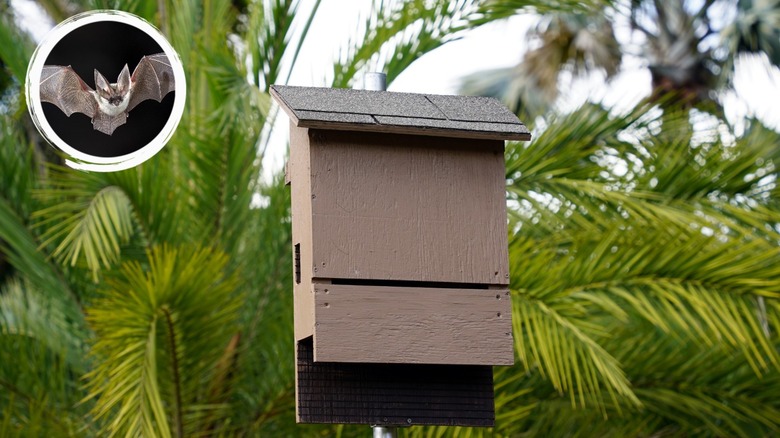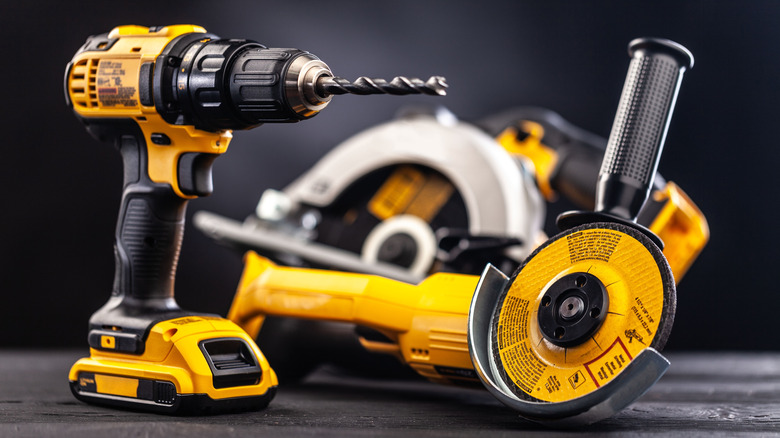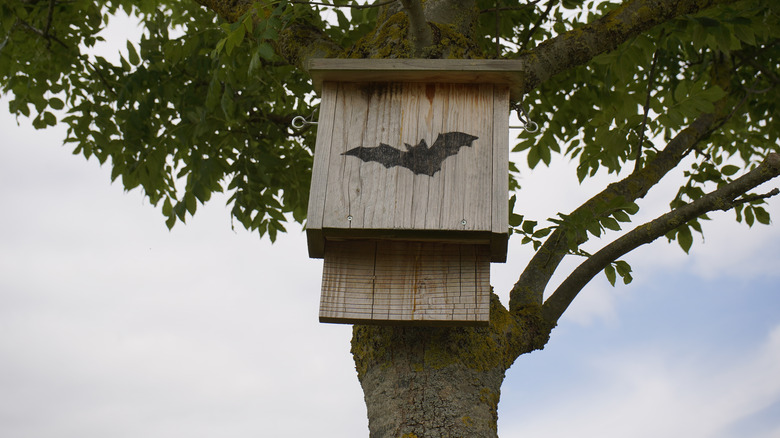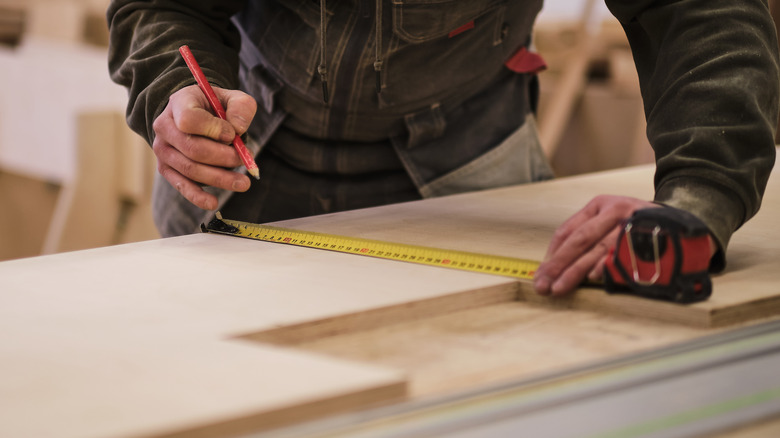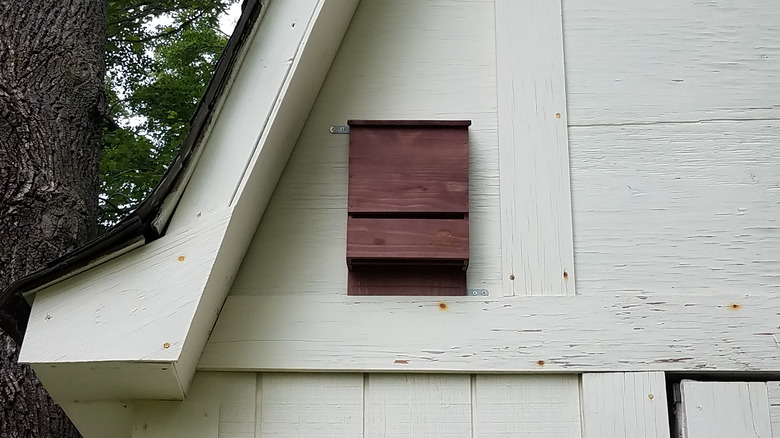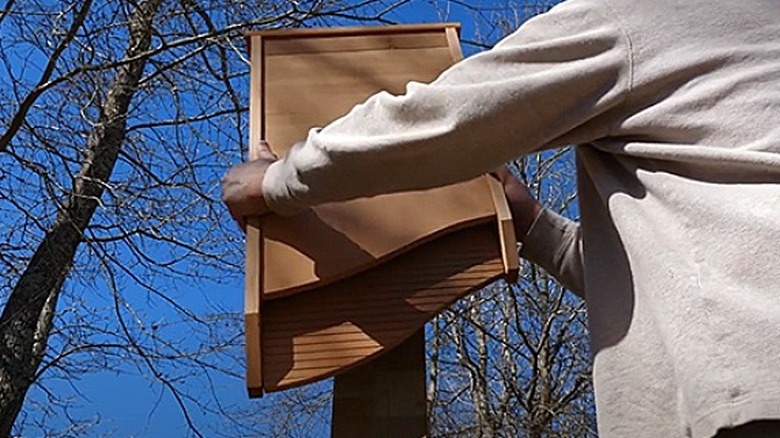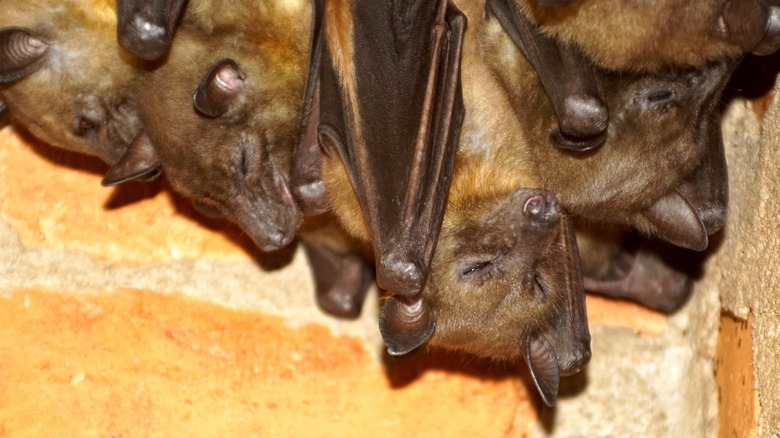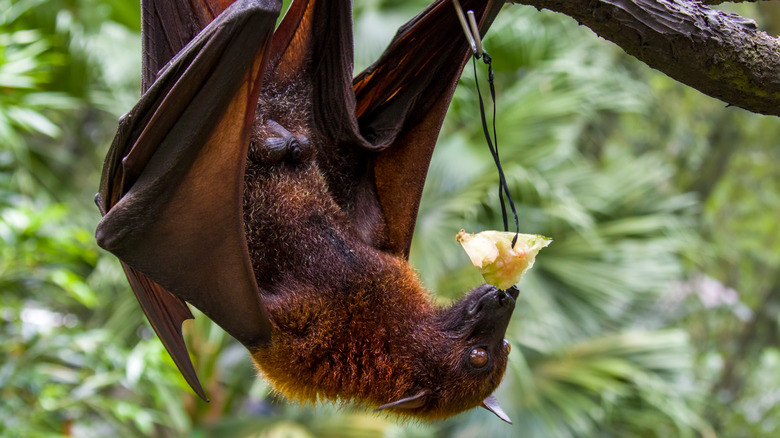How To Build A Bat House
It may seem natural for companion pets like dogs to have their own house, but what about wild, nocturnal animals like bats? If your backyard seems to have gone batty, you might consider building a bat house. With over 1,000 various bat species worldwide, the dark knights typically mate from late summer into fall, which means new pups, or pups, arrive on the scene the next summer, per Buildipedia. Known to be the only flying mammals, bats are excellent mosquito exterminators, as they can eat up to 1,000 each hour. They also love to snack on other nighttime bugs like beetles, chinch bugs, and moths. Building a bat house will provide shelter for these workhorses and ensure protection for their pups. Skedaddle Wildlife explains that female bats give birth once a year. The house will offer a much-needed safe environment for them to nurse and raise their pups until they're ready to fly. This takes a minimum of three to six weeks.
Another reason is to help the little brown bats who are facing a decline. According to Mongabay, more than 90% are dying of a fungal disease called white-nose syndrome, making them an endangered species. Found all around the globe, little brown bats roost with their young in trees during summer. They generally like to hunt for insects near ponds and streams, while habituating under bridges, mines, and other various dark-creviced structures. Keep reading to learn how to build your own bat house!
Determine which type of bat house to build
Many bat houses may appear like a large mailbox or birdhouse. The best kind of bat house is one that is similar to their regular habitat like dim crevices between rocks or under rotting tree bark. According to The Nature Conservancy, there are two main bat houses that are most effective — traditional (single or multi-chambered) and the rocket box (typically four-sided). Traditional looks like a wooden vent with multiple slot openings. Rocket is tall, long, and narrow like a rectangular tree trunk.
The correct size is important. The taller and wider for either type, the better, plus having at least three chambers inside; the larger it is, the more space they can inhabit. Whichever box you choose, the house should be at least 24-inches tall with deep cavities about 24-inches in depth and 14- to 16-inches wide, including a place to touch down at least 3 to 6 inches below the entryway. Also, if you live in a climate where the average temperature is consistently 85 degrees, make sure to include small openings for proper ventilation or it will be too hot for them. According to Mass.gov, the vents or openings should be present on either side to prevent the bats from overheating. Make sure front vents are an equal length as the box is wide. Potential side vents should be 6-inches x ½-inch wide.
Materials and tools to build your bat box
When constructing your bat house, the most common material is wood, as it's easy to work with, although plastic or fiber-cement board have better longevity with less upkeep. For wood, choose rough, nontoxic material combined with ACX, BCX or T1-11 grade exterior plywood and cedar; nothing pressure-treated. The plywood should be approximately ½-inch thick with four plies. Make sure to use exterior grade screws like galvanized, coated, or stainless steel, which are made to sustain outdoor weathering. According to Shop 4 Fasteners, stainless steel can be more expensive, but the quality is worth it in the long run.
Main tools to have on hand for constructing your bat house are a caulking gun, latex caulk, circular, table or hand saw, biscuit joiner, drill with 1/16" bit, level, tape measure, speed square, wood glue, clamps, and your cedar boards. Also, include work gloves and goggles for your own protection during the construction, plus other items you might need to accomplish the job.
Cost of bat house materials
Building a bat house should be simple, just make sure all your materials and tools are in place. According to the Potomac River Commission, sometimes the value of the tools is much more than the price of the bat house itself. If you're building more than one, you'll require double the amount materials. You may also want alternative tools like a circular or table saw rather than a hand saw. Supplies might range be $10 to $20, while the cost of tools can be $250 or more, depending on the style and brand you choose.
One way to save money might be to use surplus lumber or possibly get access to a lumber yard that offers up scrap wood. With tools, you might ask a friend or neighbor that has what you need, or you could rent a power tool from your local home improvement store. Depending on how long you need it, prices will vary from a few hours to a few weeks.
How to build a bat house
Although assembling a few wood planks seems informal, it's smart to create a design of your exact vision before you officially start. Once decided, measure and cut the plywood (2-foot x 4-foot x ½-foot) — you'll need at least three pieces. For example, 24 x 26½-inches for the back plate and 24 x 16½-inches for the top half of the front piece. What's remaining will be used on the bottom half of the front plate. To create roosting grips for the bats, use a sharp blade or saw set to 1/16" to cut grooves into the back plate that are spaced about ¼- to ½-inch apart. Per Gardener's Path, using the blade to make the grooves might offer more control. According to Urban Wildlife Control, you can use hardy plastic mesh as an alternative to roughening the wood by attaching a 20 x 24½-inch section to the backboard before bringing it all together.
Depending on your design, next assemble the board pieces. You might add furring strips, or narrow strips of wood which are included for spacing within the interior of the house. Caulk the strips onto the grooved side of the back plate. Continue to assemble and seal your pieces, including the roof, until finished making sure all the joints are caulked tightly, as this will stabilize a warm temperature for the bats.
Where to place your bat house
It's important to choose the best location for your bat house. First, avoid installing the box on trees unless you can mount them very high up. Although it looks like an ideal spot, bats need at least 12 to 20 feet to drop down and fly. A great option is to fix it under the overhang of your house, barn, or garage. This will also keep them warm and safe from predators like owls, hawks, and snakes, per Bat Conservation International. If you don't want them so close to your property, you might mount them on a pole, especially with multi-chamber boxes or multiple single chamber types. Make sure the box is 20 to 30 feet away from other trees as well for spacious flight. The bat house can be mounted on structures made of wood, brick, or stone, but bats rarely like metal.
What color can a bat house be? Typically, bat houses should be painted with neutral tones like gray, brown, black, or white. Where you live is also a factor. Use a bat house color map to determine the right shade for your location. Additionally, avoid painting or staining the inside of the house or landing area, as bats require a natural surface to settle onto. You could use a saw or other cutting tool to roughen up the interior, making it easier for them to perch.
How to install your bat house
Bats require an abundance of heat to thrive, so when you install your bat house, one of the most important things is to place it facing southeast or southwest to receive 2 to 8 hours of direct sunlight. Snug in their box, especially during the night, bats keep warm by huddling together in a confined space to retain body heat, per Big Bat Box. Measure for proper screw placement, then secure long wooden rails (1 x 2-inch or 1 x 4-inch boards) to your bat house using 1½-inch screws. Clamp the rails in place, then drill your box into the house. You might want to add caulking for extra support.
When mounting your bat box on a pole or post, make sure it's near a water source, yet at least 25 feet away from the edge. There are a few types of mounts to consider: pivot, steel, or wood. According to Wild Yards, a telescoping pole is considered one of the best picks, because you can adjust the height whenever needed, although wood may be a more common choice. When using wood, level and secure a mounting post about four inches from the top of the post, then slide on and secure your bat box. From there, dig a hole about 3 to 4 feet deep in a safe area. Finally, slide the post into place and stabilize it using concrete mix like Quikrete.
How to attract bats to their new house
If you build it, they will flock — or maybe not. For your furry friends to like their new home, it needs to feel safe and comfortable from the start or they might desert it. If your guests are not making an appearance, double check that it is placed high enough (at least 12 feet off the ground) while receiving enough sunlight with water access nearby. Per World Birds, you might try planting flowers they like such as goldenrod and honeysuckle, or night-bloomers like moonflower, which also attract nighttime insects. Keep dead trees around too, as they like to nestle between the wood and the bark. Illuminating the exterior of your house or yard can also attract bats by enticing bugs.
Time it right. According to Organic Lesson, spring and early summer are the best times for roosting activity to occur. Once they've moved in, don't walk underneath it to avoid any kind of interference. While it may be hard to know if bats are inhabiting the box, you can look for small black droppings (or guano) on the ground in the morning or evening to be certain.
Have no fear of your neighboring bats
Have no fear, bats are here. Although often associated with diseases like rabies and sucking blood like vampires, bats are an essential part of our ecosystem because of their natural talents as pest controllers, flower and fruit pollinators, and seed dispersers. According to Grow, injuring bats does not decrease the chance of diseases being spread; it can have a reverse effect when they are unnecessarily handled. Do bats bite? Although bats do have sharp teeth for chomping bug shells, there are only a few species located in Central and South America that are considered vampire bats and suck blood, per Citizen Times. Watch, observe, and take the time to understand these flying creatures of the night from a distance to lessen any anxiety.
While you become familiar with your new batty friends, make sure to examine your bat box every year or so for any damage or potential insect invasions. This can be done in the cooler months when they are hibernating elsewhere. If the box is free of pests, then leave it as is.
